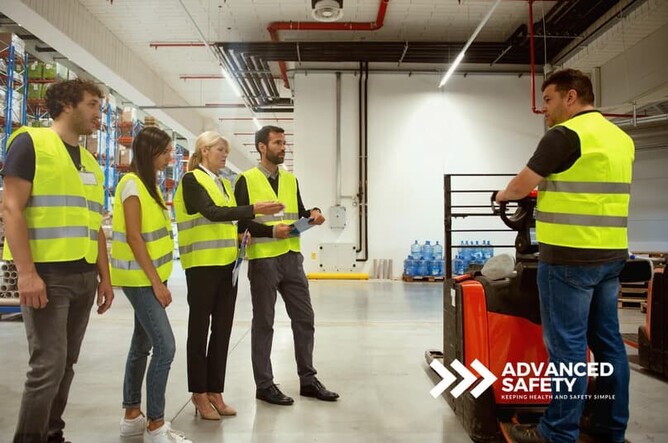Ensuring workplace safety is critical for protecting employees, maintaining productivity, and complying with legal requirements. The importance of health and safety in the workplace extends beyond simply preventing accidents - it fosters a culture of well-being, reduces financial risks for businesses, and enhances overall job satisfaction.
This article explores why workplace safety matters, the key legal frameworks involved, and practical steps for ensuring compliance.
Understanding Why Health and Safety Is Important in the Workplace
Workplace health and safety refers to the policies, procedures, and measures designed to protect employees from harm while they perform their duties. A strong health and safety framework helps prevent injuries, illnesses, and long-term health conditions caused by work-related activities. It also promotes a positive work environment where employees feel safe, valued, and engaged in their roles.
What Does Health and Safety Cover?
Workplace health and safety includes a range of considerations, including:
Physical Hazards – Preventing slips, trips, and falls through hazard identification and mitigation.
Chemical and Biological Risks – Managing exposure to hazardous substances and ensuring proper handling procedures.
Psychosocial Well-being – Addressing workplace stress, bullying, and mental health challenges.
Ergonomic Concerns – Designing workstations and practices that reduce strain and repetitive injuries.
By addressing these areas, businesses create safer work environments that lead to higher productivity, reduced absenteeism, and improved employee morale.
Legal Requirements: Why Is Health and Safety Important in the Workplace?
Adhering to workplace health and safety regulations is not just beneficial—it is a legal necessity. In New Zealand, businesses must comply with The Health and Safety at Work Act (HSWA) 2015, which sets out clear obligations for employers and workers.
Key Legal Frameworks
Health and Safety at Work Act (HSWA) 2015 – Requires businesses to proactively manage risks, train employees, and provide safe work environments.
WorkSafe NZ – New Zealand’s regulatory body that enforces workplace safety standards and offers compliance guidance.
Industry-Specific Regulations – Construction, manufacturing, and healthcare sectors must meet additional safety requirements tailored to their risks.
Employer and Employee Responsibilities
Both employers and employees play a role in maintaining workplace safety:
Employers Must: Identify hazards, conduct risk assessments, implement control measures, and provide necessary training and protective equipment.
Employees Must: Follow safety protocols, report hazards, and use protective equipment correctly.
Failure to comply with legal requirements can result in significant fines, reputational damage, and legal action, making compliance an essential part of business operations.
Want to Improve Your Workplace Safety?
Contact Advanced Safety for expert guidance and support.
Contact Us TodayBenefits of Prioritising Workplace Health and Safety
Implementing comprehensive health and safety measures offers numerous advantages for both businesses and employees. Below are some of the most impactful benefits:
1. Reduced Workplace Accidents and Injuries
Preventing accidents not only protects employees but also reduces downtime and productivity loss. Key strategies include:
Conducting routine safety audits to identify risks.
Implementing clear safety protocols for all work activities.
Providing employees with personal protective equipment (PPE).
2. Improved Employee Well-being and Engagement
A safe work environment promotes a culture where employees feel valued and supported. This leads to:
Increased job satisfaction and employee retention.
Better mental health and lower stress levels.
Stronger workplace morale, fostering a more cohesive and engaged workforce.
3. Financial Savings for Businesses
Investing in health and safety helps businesses reduce:
Compensation claims and medical costs associated with workplace injuries.
Legal expenses resulting from non-compliance penalties.
Productivity losses due to absenteeism or staff turnover.
Workplace safety measures, while requiring upfront investment, often lead to long-term cost reductions and improved efficiency.
Common Workplace Hazards and How to Mitigate Them
Understanding common workplace hazards is essential for preventing accidents and ensuring compliance with safety regulations. Below are five major categories of workplace hazards and how businesses can address them.
1. Physical Hazards
Includes risks such as falling objects, moving machinery, and unsafe work surfaces.
Solution: Conduct regular site inspections, provide proper PPE, and ensure employees receive training on safe equipment use.
2. Ergonomic Hazards
Caused by poor workstation setup, repetitive motions, and improper lifting techniques.
Solution: Offer ergonomic workstations, encourage frequent movement breaks, and train employees on safe manual handling techniques.
3. Chemical Hazards
Exposure to toxic substances such as cleaning chemicals, industrial solvents, or airborne pollutants.
Solution: Implement strict chemical storage and handling procedures, provide appropriate PPE, and ensure proper ventilation in workspaces.
4. Biological Hazards
Risks associated with exposure to bacteria, viruses, or fungi, particularly in healthcare or food industries.
Solution: Maintain hygiene protocols, provide protective clothing, and ensure vaccinations where applicable.
5. Psychosocial Hazards
Workplace stress, bullying, or a lack of work-life balance can impact mental health.
Solution: Foster a supportive work culture, implement clear anti-bullying policies, and offer access to mental health support services.
Creating a Strong Workplace Health and Safety Culture
Beyond compliance, building a strong workplace safety culture is key to maintaining an accident-free work environment. Here’s how businesses can achieve this:
1. Foster Open Communication
Encourage employees to speak up about safety concerns and provide regular feedback on workplace risks.
2. Provide Ongoing Training
Conduct frequent safety training sessions that keep employees informed about best practices and updates to regulations.
3. Implement a Safety Leadership Program
Engage managers and supervisors in setting the tone for workplace safety, ensuring they lead by example.
4. Recognise and Reward Safe Behaviour
Incentivise employees who actively contribute to workplace safety, reinforcing a proactive safety culture.
Want to discuss your safety goals?
Contact Advanced Safety for professional guidance and support.
Contact Us TodayConclusion: Why Is Health and Safety Important in the Workplace?
Health and safety in the workplace is more than just a regulatory obligation—it is a critical aspect of fostering a productive and positive work environment. By implementing robust health and safety measures, businesses can protect employees, enhance efficiency, and safeguard their reputation.
From understanding legal requirements to addressing common workplace hazards, prioritising safety is a key factor in business success. Employers and employees alike must take responsibility for maintaining a safe work environment to ensure the long-term well-being of everyone involved.
Want to improve workplace safety? Contact Advanced Safety today to ensure your organisation is compliant, efficient, and prepared for the future.



